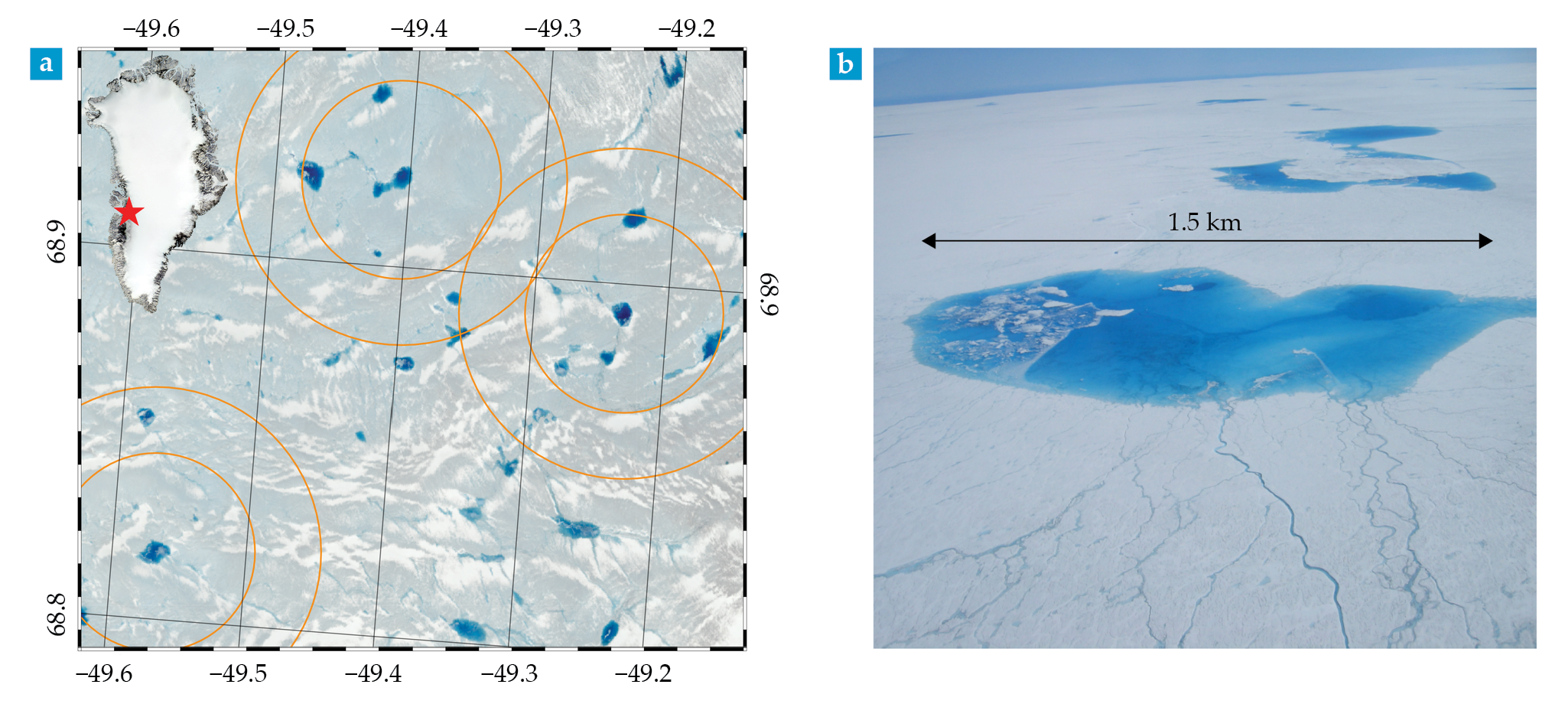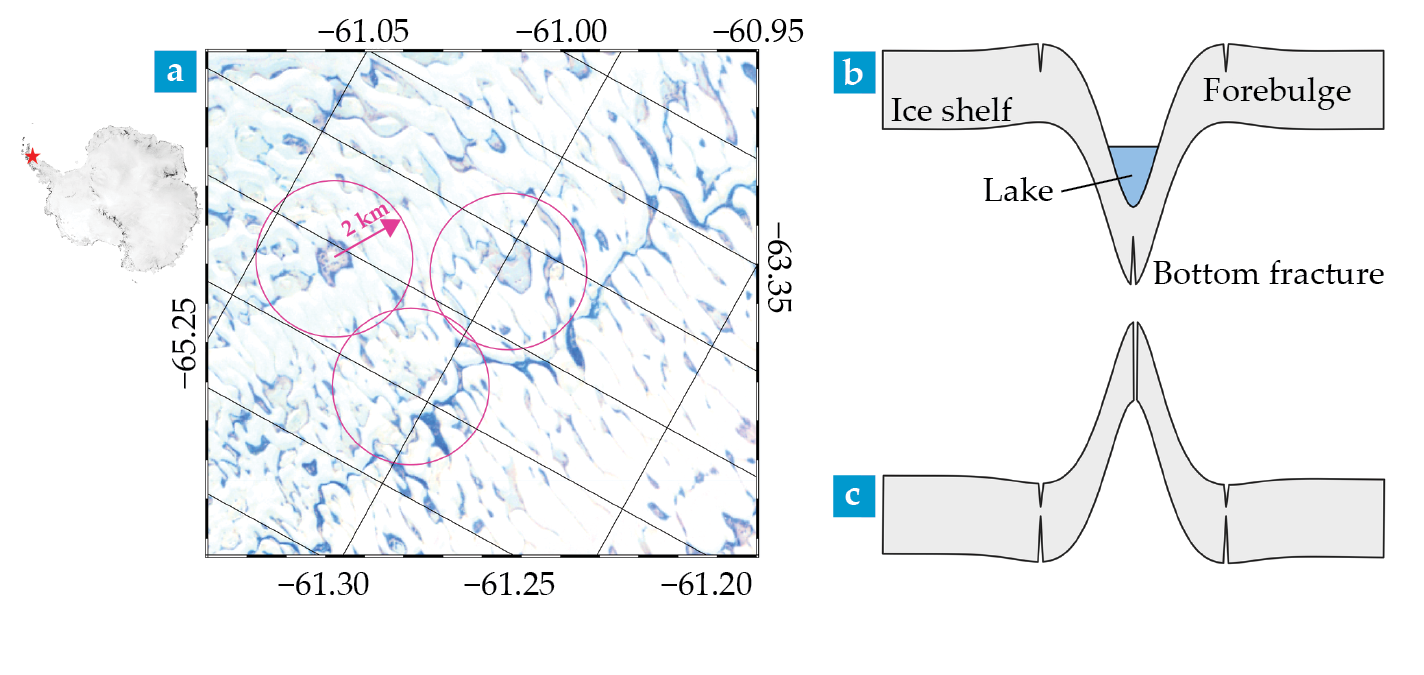Small lakes could destabilize Earth’s ice sheets
DOI: 10.1063/PT.3.5333
At the poles, unlike elsewhere on Earth, the day–night cycle lasts a full year rather than 24 hours. Annually, each pole has a single sunrise and a single sunset. Such a year of extremes guarantees long winters and summers intense enough to melt some, but not all, of the snowfall. The cycle gives rise to the planet’s ice sheets.
The Greenland Ice Sheet holds an amount of water equivalent to 7 m of global sea-level rise, while the East and West Antarctic Ice Sheets lock away 60 m. Summertime meltwater is plentiful in Greenland, but in Antarctica, it is found only around the fringes.
On the ice sheets, natural surface depressions collect meltwater into lakes—a few kilometers wide and a few meters deep—as shown in figure
Figure 1.

Supraglacial lakes (a) within a 20 × 20 km area (red star in the inset) of the Greenland Ice Sheet are imaged by satellite on 12 June 2018. Orange circles around three of those lakes mark the estimated 3–5 km radius where one lake drainage can induce another. (b) This supraglacial lake is pictured before the water fractures the ice.

The same technique—fracking—is used by the oil and gas industry. In that case, however, drillers must artificially pressurize the water to fracture shale rocks, whose density is 2500 kg/m3. On ice, gravity alone is sufficient.
Lakes can speed up ice glide
Ice in the Greenland Ice Sheet flows in two ways: by deforming, which moves ice tens of meters per year, and by sliding atop water that lubricates its base, which moves ice several kilometers per year. Some 95% of that water comes from the surface through fractures, many of which are initiated at supraglacial lakes. Those fractures occur quickly: In just a few hours, they propagate hundreds of meters deep and drain about 1010 liters of water to the bed, with water flux exceeding that over Niagara Falls.
Underneath the ice, the arriving water produces a fluid-filled blister that jacks up the ice locally and eliminates the ice–bed friction that usually resists ice flow. Over time, the water diffuses outward, the blister decays, and friction returns, but the initial perturbation induces important temporary changes.
The surface is uplifted about 1 m, and the speed of the ice increases enough to stretch the ice by 0.1–1% per year. If the accompanying induced stresses exceed the tensile strength of ice, new fractures appear in and around the lake basin. Crucially, if those fractures coincide with a second lake, that lake water can fracture ice to the bed, which can produce another blister that may open new fractures in other lake basins and drain them as well. Observations bear that process out: Every summer, clusters of a dozen or so Greenland lakes drain within a few days of each other.
Those events are controlled by two length scales: (A) the distance over which the water blister creates new surface fractures, and (B) the distance between lakes. The estimated range of A (3–5 km) exceeds that of B (1–2 km) and thus allows a wave of lake drainages that propagates both down-glacier and up-glacier. As the wave proceeds down-glacier, A generally increases while B decreases, making it likely that all lakes down-glacier will drain.
Approximately 100 km inland from the coast, however, B rises above A; the lakes are spaced too far apart to intersect the fractures induced by the water blister. But in the near future, as the climate warms and the ice sheet thins, A will increase and the intersection point will move farther inland, causing new lakes to drain. That, in turn, will send water to drier inland areas of the bed, where the subglacial water system is less well developed or even absent. The process could, in theory, make the ice slide faster into the sea and thus thin the ice sheet further.
Are waves of lake drainages a tipping point for ice-sheet stability? Possibly, but it is a slow mechanism: It relies on viscous ice flow to thin the ice and lower the surface to elevations where summer temperatures exceed 0 °C and meltwater lakes can form. Total destruction of the ice sheet that way could take thousands of years. Other mechanisms that can destroy an ice sheet, such as icebergs calving into a warmer ocean, happen more rapidly. Importantly, the time scale of destruction of the Greenland Ice Sheet is primarily sensitive to the rate at which Earth warms. More anthropogenic warming and thus a faster time scale—perhaps just 1000 years—seem likely, but so far no process has tipped the system into instability.
Lakes can disintegrate ice shelves
At Earth’s opposite pole, Antarctica is ringed by ice shelves—floating extensions of the great Antarctic ice sheets. Because the ice shelves are floating, some 90% of their ice is underwater, leaving their surfaces only dozens of meters above sea level. That low elevation means warmer temperatures and meltwater in the austral summer.
The Larsen B Ice Shelf on the Antarctic Peninsula once hosted thousands of meltwater lakes each summer, as shown in figure
Figure 2.

On the Larsen B ice shelf in Antarctica, (a) supraglacial lakes in a 14 × 14 km area are imaged by satellite on 21 February 2000, two years before the ice shelf’s disintegration. Pink circles show the 2 km flexure radius from three lakes. (b) An idealized profile of an ice shelf is pictured before collapse, with a lake and the features it induces: a central basin and a radial forebulge 2 km away and tens of centimeters high. Surfaces in extension are prone to fracture. (c) A profile of the same area is pictured after the lake’s drainage induces isostatic rebound and inverts the forebulge, where new fractures form at the same sites but on the opposite surface.

Accordingly, stress-induced fractures form on the bottom of the new forebulges, directly below the original fractures. If a second lake coincides with the fractures, they may drain the water. That occurred on the Larsen B Ice Shelf in 2002. Hundreds of lakes drained in just a few weeks by forming a checkerboard of rifts that disintegrated the ice shelf.
Before 2002 the ice shelf resisted the flow of the glaciers feeding it. Its disintegration increased the seaward ice flux in those glaciers by 50%, although the flow speeds have relaxed toward their initial values. Fortunately, the ice shelf catchment was only 6300 km2, the size of Delaware; total sea-level rise induced by the ice-shelf collapse and the glacier response in the ensuing 21 years is less than 1 mm. Compare that with the 14 million km2 of Antarctic glacial ice as a whole, which has contributed 8 mm of global sea level rise since 2002, most of it caused by warmer ocean waters accelerating ice flow in West Antarctica.
Some 60% of Antarctic ice is up-glacier of an ice shelf, which would make it vulnerable to acceleration if the ice shelf were to be lost. The Ross and Filchner–Ronne Ice Shelves, which collectively buttress 40% of the continent, currently see virtually no surface melt. They are also significantly thicker than the Larsen B, so flexures and fractures are inhibited. Disintegration of those major ice shelves by lake-induced flexure would require both ice-shelf thinning and additional atmospheric warming that are likely centuries to millennia away. At least four ice shelves on the Antarctic Peninsula, however, have collapsed through that mechanism. As in Greenland, the fate of the remaining ice shelves is tied to future atmospheric warming.
References
► A. F. Banwell, D. R. MacAyeal, O. V. Sergienko, “Breakup of the Larsen B Ice Shelf triggered by chain reaction drainage of supraglacial lakes,” Geophys. Res. Lett. 40, 5872 (2013). https://doi.org/10.1002/2013GL057694
► L. A. Stevens et al., “Greenland supraglacial lake drainages triggered by hydrologically induced basal slip,” Nature 522, 73 (2015). https://doi.org/10.1038/nature14480
► J. Stock, “Modeled patterns of crevassing induced by supraglacial lake drainage in western Greenland,” MS thesis, U. at Buffalo (2020).
More about the Authors
Kristin Poinar is an assistant professor in the department of geology at the University at Buffalo in New York.

